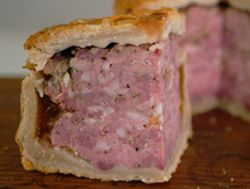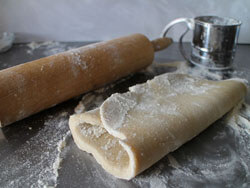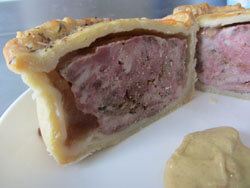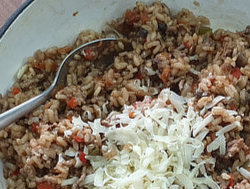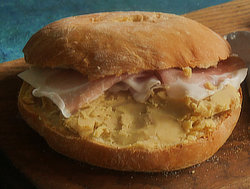
Northern-style Pork Pie
Introduction & method
Unlike their cousins from the midlands and Melton Mowbray, these little pork pies are best eaten while still hot and the savoury jelly is still runny. Messy but perfect.
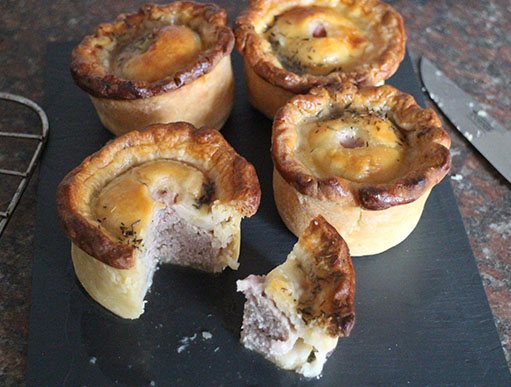
Make the Pastry
Pork pies are always made with Hot Water Pastry. This is probably the simplest pastry to make, and it can withstand a lot of handling, thumping and rolling.
Chop the lard into small chunks, put it in a small pan with the water and bring it to the boil. When all the lard has melted, remove from heat. In a large bowl, mix the salt with flour, and then add the water and lard. Mix with a wooden spoon, then tip out onto the worktop and knead lightly until everyhing is thoroughly mixed and the dough feels smooth.
Wrap the dough in plastic film and pop it in the fridge or freezer to cool down. It needs to be at room temperature when you use it.
Make the Filling
Flatten the minced pork and sprinkle some of the seasoning over it. Fold up the pork, flatten it again and sprinkle more seasoning. Keep on doing this until all the seasoning is evenly incorporated. Divide the pork into 12 equal balls.
Assemble the Pies
You'll need something like a muffin tin or small pudding basins - about 50mm (2 inches) diameter. Grease the insides with butter or lard. Roll out about one third of the pastry into a sheet 3mm (just under a quarter of an inch) thick. Find a cutter or glass that's the same diameter as your tins and stamp out 12 discs for the lids. Use the narrow end of a funnel to cut a hole in the centre of each lid - this is to let the steam escape and can be used to pour the jelly in after baking.
Roll out more pastry and cut it into rough squares, about 12cm (4 inches). Generously sprinkle on side of a pastry square with flour and press it into a tin, floured side down - this extra flour helps stop the pies from sticking. Stretch the pastry into the mould until it reaches the bottom. Try not to get any folds or creases in the pastry. Cut away the excess pastry, leaving a rim of 3-4mm (quarter of an inch).
Pop a ball of filling into each tin, moisten the pastry rim with water and press a lid on. Press it firmly all round to make a good seal, then lift up the rim so that it is not stuck to the tin. You may do some fancy crimping if you wish.
Paint the tops of the pies with beaten egg and sprinkle each one with thyme or sage.
Bake the Pies
Preheat oven to 160°C (320°F) for a fan/convection oven, 180°C (356°F) conventional, gas 4. Bake the pies for 20 minutes. Remove them from the oven, and then carefully remove each pie from its tin and place on a baking tray lined with a silicon mat or greaseproof paper. Bake for a further 30 minutes - turn the tray around after 15 minutes to get an even bake. You don't have to remove them from the tins as I do, but I find you get a better pie this way - no soggy bottoms or sides!
Make the Jelly
Dissolve a chicken stock cube in 400ml (13 fl. oz.) boiling water. Dissolve 6 grams - half a sachet - of powdered gelatine in hot water. Add the gelatine to the stock, stir well, and simmer for a few minutes until everything is thoroughly dissolved.
Finish the Pies
Remove the pies from the oven and let them cool on the baking tray for 10-15 minutes. Transfer them to a wire rack and put the jellied stock in. If you have a syringe (sometimes called a flavour injector), use that to inject as much jelly as you can into each pie - stick it in close to the edge, between the meat and the wall of the pie. If you don't have a syringe you can pour the jelly in through the centre hole using a funnel.
For the traditional jelly-dribbled chin experience, eat the pies straight away. But they are still brilliant when they've cooled down and the jelly has set.
Ingredients & Info
PASTRY
 500 grams plain white (all-purpose) flour
500 grams plain white (all-purpose) flour 200 grams lard
200 grams lard 250 ml water
250 ml water 1 tsp salt
1 tsp salt FILLING
FILLING 750 grams minced pork
750 grams minced pork 1.5 tsp seasoning mix
1.5 tsp seasoning mix JELLY
JELLY 400 ml chicken stock
400 ml chicken stock half a sachet powdered gelatine
half a sachet powdered gelatine 50 ml water
50 ml waterPLUS
Pork seasoning mix: I blend 1 part salt, 1 part thyme or sage and 2 parts ground white pepper. You will also need extra butter or lard to grease the tins, and a beaten egg to glaze the pies.
Prep time: 20 minutes.
Cooling/resting time: 30 minutes.
Cooking time: 50 minutes.
Total time: 1 hour 40 minutes.
